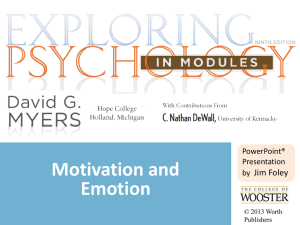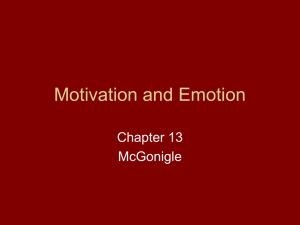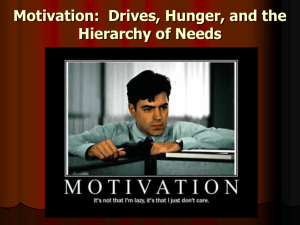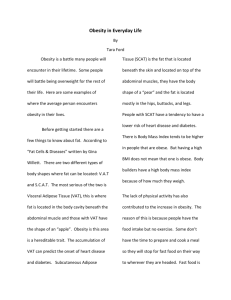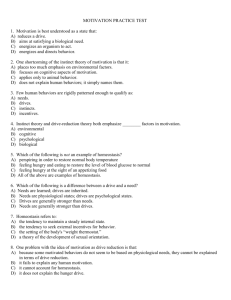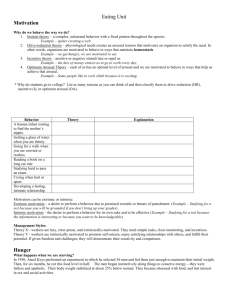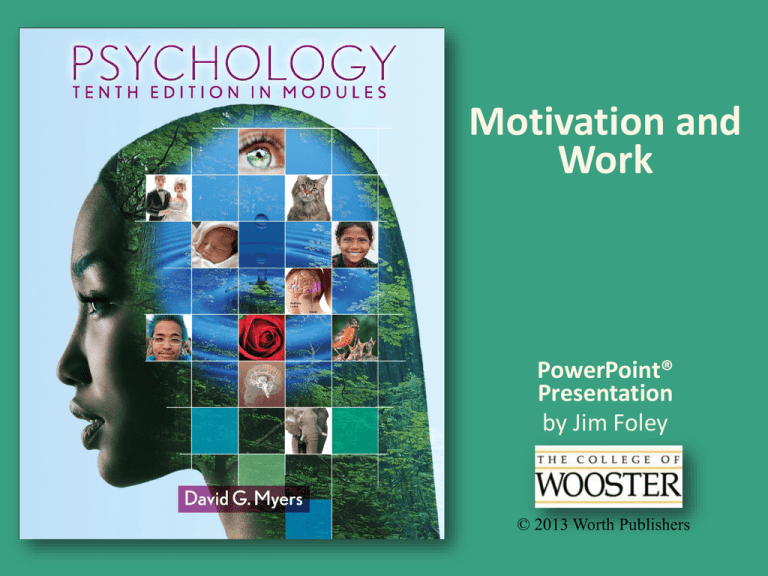
Motivation and
Work
PowerPoint®
Presentation
by Jim Foley
© 2013 Worth Publishers
Module 32: Basic Motivation
Concepts, and Hunger
Motivation
Motivation refers to a
need or desire that
energizes behavior and
directs it towards a
goal.
For example, Aron Ralston
found the motivation to cut off
his own arm when trapped on a
cliff in Utah in 2003.
What motivated him to do this?
Hunger? The drive to survive?
The drive to reproduce?
Perspectives on Motivation
Instinct Theory
Evolutionary
Perspective
Hierarchy of
Needs/Motives
There are different
ways of thinking of
the way motivation
works, all of which
relate to the
“push” of biological
processes and the
“pull” of culture,
social forces, and
ideals.
Arousal
[Optimization]
Theory
DriveReduction
Theory
Do Instincts Direct Human Behavior?
An instinct is a fixed (rigid and predictable) pattern of
behavior that is not acquired by learning and is likely to
be rooted in genes and the body.
Human
“nesting”
behavior
Instinctual
nesting
Instincts Evolutionary Perspective
Other species have genetically
programmed instincts
“motivating” their actions.
Do humans?
Human babies show certain
reflexes, but in general, our
behavior is less prescribed by
genetics than other animals.
We may, however, have general
patterns of behavior which can
be explained as emerging
through natural selection.
Instinct theory has given way to
evolutionary theory in
explaining human behavior.
Drive Reduction
A drive is an aroused/tense state related to a physical
need such as hunger or thirst.
Drive-reduction theory refers to the idea that humans
are motivated to reduce these drives, such as eating to
reduce the feeling of hunger. This restores homeostasis,
a steady internal state.
Seeking Optimum Arousal
Some behavior cannot
be easily connected to
a biological need, and
instead seems driven
by a need to either
increase or decrease
our physiological
arousal level.
Curiosity, as with kids
and these monkeys,
may be a way of
increasing stimulation
to reach an optimum
arousal level.
Arousal Theory of Motivation
My brother, Mike is a thrill seeker!
Hierarchy of
Needs/Motives
In 1943, Abraham
Maslow proposed
that humans
strive to ensure
that basic needs
are satisfied
before they find
motivation to
pursue goals that
are higher on this
hierarchy.
Violating the
Hierarchy?
Do hunger strikers
and mystics feel
secure enough in
meeting their needs
that they can do
without food
temporarily to
pursue a higher
goal?
Soldiers sacrifice safety, but could
they be seen as fighting for safety,
both indirectly (protecting the
country) and directly (defeating
the people shooting at them)?
After spending years in the ocean, a
mature salmon swims up its home
river to return to its birthplace. This
behavior is an example of:
A.
B.
C.
D.
homeostasis.
a set point.
a refractory period.
an instinct.
A closer look at one need/motive:
Hunger
Research on hunger is
consistent with Abraham
Maslow’s hierarchy:
In one study, men
whose food intake had
been cut in half became
obsessed with food.
Hunger even changes
our motivations as we
plan for the future.
Physiology of Hunger
Experiments and other investigations show a complex relationship
among the stomach, hormones, and different parts of the brain.
Feeling hungry causes stomach contractions, but the feeling can
happen even if the stomach is removed or filled with a balloon.
The Hypothalamus and Hunger
Receptors throughout the digestive system monitor levels
of glucose and send signals to the hypothalamus in the
brain.
The
hypothalamus
then can send
out appetitestimulating
hormones, and
later, after
eating,
appetitesuppressing
hormones.
The Body Talks Back to the Brain
Hormones travel from
various organs of the
body to the brain (the
hypothalamus) to
convey messages that
increase or decrease
appetite.
When scientists put 36
conscientious objectors on a semistarvation diet for six months, all of
the following occurred EXCEPT:
A.
B.
C.
D.
the men appeared listless and apathetic.
the men became obsessed with food.
the men spent more time thinking about sex.
the men lost interest in social activities.
In a classic experiment, obese patients
whose daily caloric intake was dramatically
reduced lost only 6 percent of their weight.
This limited weight loss was due, at least in
part, to the fact that their dietary restriction
led to:
A.
B.
C.
D.
a proliferation of their lymphocytes.
the inhibition of their dopamine reuptake.
a sharp decrease in their metabolic rates.
a dramatic surge in their cholesterol levels.
Regulating Weight
When a person’s weight drops or
increases, the body responds by
adjusting hunger and energy use
to bring weight back to its initial
stable amount.
Most mammals, without
consciously regulating, have a
stable weight to which they keep
returning. This is also known as
their set point.
A person’s set point might rise
with age, or change with
economic or cultural conditions.
Therefore, this “set point” of
stable weight is more of a
current but temporary “settling
point.”
Which foods to eat?
Taste Preferences
Some taste preferences
are universal.
Carbohydrates
temporarily raise levels
of serotonin, reducing
stress and depression.
Other tastes are acquired
and become favorites
through exposure,
culture, and
conditioning.
Different cultures
encourage different
tastes.
Some cultures
find these
foods to be
delicious:
reindeer fat
and berries,
or roasted
guinea pig.
Biology, Evolution, and Taste Preferences
Differences in taste preferences
are not arbitrary. Personal and
cultural experience, influenced
by biology, play a role.
We can acquire a food
aversion after just one
incident of getting sick after
tasting a food.
It is adaptive in warm climates
to develop a taste for salt and
spice, which preserve food.
Disliking new tastes may have
helped to protect our
ancestors.
How much do we eat?
Eating depends in part on
situational influences.
Social facilitation: the
presence of others
accentuates our typical
eating habits
Unit bias: we may eat only
one serving/unit (scoop,
plateful, bun-full) of food,
but will eat more if the
serving size is larger
Buffet effect: we eat more
if more options are
available
Influences on Eating Behavior
Obesity refers
to an amount of
body fat that
increases the
risk of health
problems to the
point that
weight loss is a
health priority.
Obesity is
linked to
diabetes, heart
problems,
arthritis, and
some cancers.
Is Fat Bad?
Having some body fat is
normal and healthy; fat stores
energy effectively for later use.
Body fat has been seen as a
sign of affluence, and thus has
been considered attractive.
Standards vary in different
cultures, sometimes creating
an unhealthy norm of being
overweight or underweight.
Being mildly overweight is not
considered a problem if the
person is in good physical
condition or exercising.
Obesity and Life
Expectancy
Obesity and Weight
Control
How does obesity develop,
and why is it hard to change?
It was adaptive for our
ancestors to crave energy-rich
food when available.
Problem: energy-rich ‘junk’
food is now easily available,
and cheaper than healthy food
It is adaptive to slow down our
burning of fat when food is
scarce.
Problem: in crash diets, our
body can slow down weight
loss
Physiology of Obesity
Once a person is obese,
losing weight is not so
easy as “just eating less.”
Fat has a lower
metabolic rate then
other tissue, so a
person might gain
weight when eating
“normally.”
Eating less to lose
weight slows
metabolism. This
prevents weight loss,
and ensures weight
gain when returning to
a normal diet.
Even if weight loss
succeeds, a formerly
obese person will have
to eat less than an
average person just to
prevent weight gain.
Genetics and Obesity
Social Psychology Adopted siblings eating the same meals
of Obesity
end up with a BMI/weight resembling
biological parents, not people in the
Discrimination based
same household.
on weight has been
twins have similar weights, even
found to be stronger Identical
when raised apart with different food.
than race and gender There seem to be many genes with
discrimination.
effects on weight.
In one study, actors
were seen as less
employable when
made to look heavier.
Even children are
prejudiced against the
overweight.
Perhaps as a result,
people who are obese
are more likely to be
depressed or isolated.
Lifestyle Factors and Obesity
People who are restless and fidgeting
burn off more calories and gain less
weight than others.
Inadequate sleep causes weight gain,
despite increased active time, because of
appetite hormones.
Having an obese friend correlates with
becoming obese.
Sedentary lifestyles and fast food may be
leading to increased body fat worldwide.
Losing Weight: The Challenge
Because of the physiological factors and perhaps due to
lifestyle and peer issues:
once obese, weight loss is difficult, and permanent weight
loss is even harder.
obsessive weight loss attempts can add to shame, anxiety,
depression, and disordered eating habits.
Losing
Weight:
The Plan
If you decide to
move your
body’s set point
to a lower body
weight:
Begin with an understanding of the
metabolic challenges you face, so that you
blame slow progress on physiology, not
poor willpower.
Begin with self-acceptance and a decision
to change, rather than feeling shame.
Make gradual and consistent, not drastic
and varying, lifestyle changes.
Increase exercise and healthy food
choices.
Get support.

